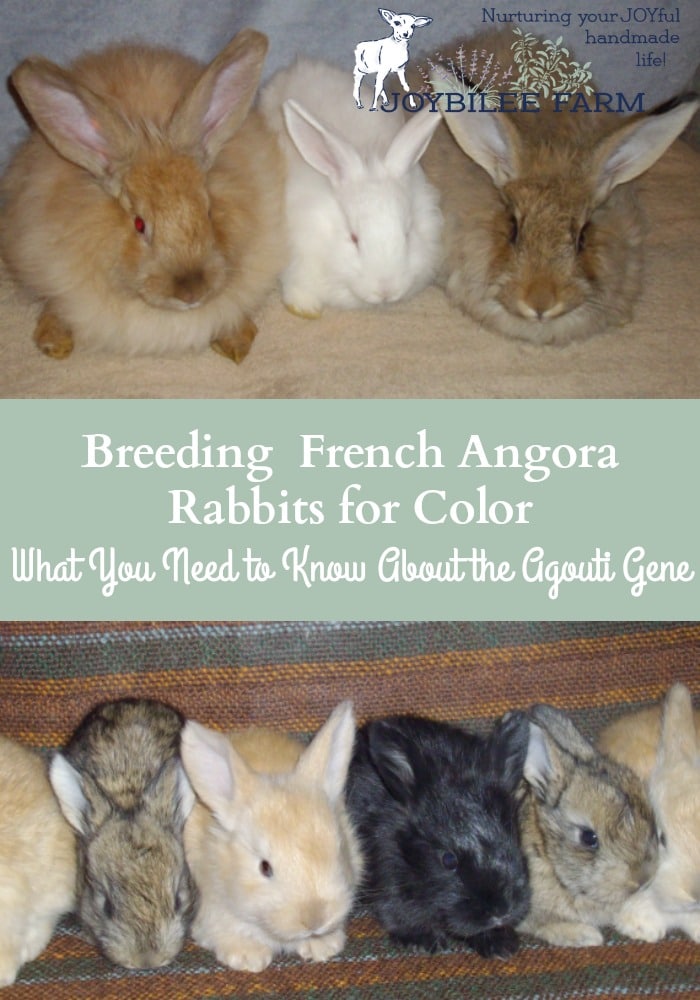Breeding French Angora Rabbits for Colour, What You Need to Know About the Agouti Gene
If you are breeding Angora rabbits for wool then you need to know about the agouti gene. This gene dictates the colour. Learn more about it here.
This is a series of posts on raising Angora Rabbits Organically, for their soft, luxurious fibre and for their babies, for wool and for homestead meat. Check out the whole series under Angora Rabbits 101.
Today, I want to continue talking about Angora Rabbit Genetics, focusing on the agouti gene, which is the dominant gene in Angora Rabbits. When we see a wild rabbit, we are seeing the agouti gene expressed. Rabbits that carrying that gene will exhibit agouti colouring because the agouti gene is the dominant gene.
Solid coloured rabbits, called “self” in discussions of rabbit colouring, do not carry the agouti gene. The agouti gene modulates the colour of each hair shaft so that each hair exhibits several colours. When you blow into the coat of angora with an agouti gene, you see bands of colour, rather than a solid colour down the shaft. The agouti rabbit’s colour is defined by the order of the bands of colour exhibiting on the hair shaft of a rabbit in a full coat.
The fawn rabbit is an agouti rabbit. Its fibre changes colour along the hair shaft. Its face, ears, and back are coloured and the stomach is light cream.
Agouti is the dominant gene. This means if a rabbit has the agouti gene it will be evident in its coat colouring. Self rabbits do not carry the agouti gene. Ruby Eyed White rabbits may carry the agouti gene but the albino gene masks it. You will only be able to tell what genes the REW rabbit is carrying by looking at its offspring when it is bred to a non-REW rabbit.

If you breed an agouti rabbit with a self rabbit the litter will have some agouti babies in it, but only the agouti babies in the litter will be carriers of the agouti gene. If you have only self rabbits (black, blue, chocolate, or lilac) bunnies you will not be able to get any of the agouti colours in your babies, because agouti is the dominant gene. Self rabbits do carry and do not pass it on to their offspring.
The two rabbit colours and their dilute expression (Black, Chocolate, Blue and Lilac) also express in the agouti gene. Agouti rabbits with the black gene for colour are Chestnut rabbits–the wild rabbit colouring. Agouti rabbits with the Chocolate gene for colour are Chocolate Agouti. Blue agouti rabbits are called, Opal and Lilac Agouti rabbits are called Lynx. Copper Agouti rabbits have a surface colour of Rufus red and are ticked with black tipped guard hairs.
All agouti rabbits have three bands of colour in each fibre length. The bands of colour will be evident when the angora rabbit’s coat is opened. Open it by gently blowing on the surface of the back, of a rabbit in full coat. The coat opens, revealing bands of colour that appear to circle the wool in a bull’s eye pattern. The surface colour determines the colour of the rabbit, with the order of the bands of colour defining specifically which agouti colour it is.
The Chinchilla rabbit carries an agouti gene but it is expressed with only two colours repeated along the fibre length. Chinchilla is the black colour expression diluted to squirrel in rabbits that also carry the dilute expression to blue. Chocolate Chinchilla is the Chocolate colour expression diluted to lilac chinchilla in rabbits that also carry a dilute gene.

The chinchilla bunny in the background carries the agouti gene, the black gene, and the recessive chinchilla gene. The bunny in the foreground is a Pearl rabbit, carrying the shaded gene.
These 10 day old angora babies are (back to front) Chinchilla, Chestnut and Pearl. The pearl rabbit carries a shaded gene–evident by its nose shading. Their mother is a fawn rabbit and their father was an opal.
Even though there is such variety in acceptable Angora rabbit colours the wool from these rabbits and the yarn made with the wool will always fall into one of 4 colours — white, fawn, Dark to light cool grey and dark to a light warm grey.

This is part of a series of posts on Angora Rabbits 101:
Part 1 -When Fluffy Bunny Becomes Matted
Part 2 -6 steps to dealing with Sore hocks in your Angora Rabbits
Part 3 – Feeding your Angora Rabbits organically
Part 4 – Breeding for colour: Understanding Colour Genetics: The self rabbit
Part 5 – Angora Bunny Colour Genetics: The wild rabbit colouring
Part 6 – Angora Bunny Colour Genetics: The Shaded Gene




Leave a Reply